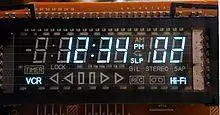cal·cu·late
词源:past participle [过去分词] of calculare, from calculus 'stone used in counting'. 微积分:calculus.
An electronic calculator is typically a portable electronic device used to perform calculations, ranging from basic arithmetic to complex mathematics.
The first solid-state electronic calculator was created in the early 1960s. Pocket-sized devices became available in the 1970s, especially after the Intel 4004, the first microprocessor, was developed by Intel for the Japanese calculator company Busicom.
solid-state: based on or consisting chiefly or exclusively of semiconducting materials, components, and related devices.
Busicom asked Intel to design a set of integrated circuits for a new line of programmable electronic calculators in 1969. In doing this, they spurred the invention of Intel's first microprocessor to be commercialized, the Intel 4004. Busicom owned the exclusive rights to the design and its components in 1970 but shared them with Intel in 1971.
On the left, the NEC TK-80 kit, based on Intel 8080 chip, on the centre, Busicom calculator motherboard, based on Intel 4004 chip, and on the right, the Busicom calculator:

The Unicom 141P and the NCR 18-36 were OEM versions of the Busicom 141-PF:

这个计算器是用纸带的,没有sin, cos等函数——用4位的CPU来实现它们,unbelievable .
原厂设备制造商OEM(Original Equipment Manufacturer)是受托厂商按来样厂商之需求与授权而生产。
Electronic calculators contain a keyboard with buttons for digits and arithmetical operations. They usually have liquid-crystal displays (LCD) as output in place of historical light-emitting diode (LED) displays and vacuum fluorescent displays (VFD). Advanced calculators may use dot matrix displays. Large-sized figures are often used to improve readability; while using decimal separator (usually a point rather than a comma) instead of or in addition to vulgar fractions. Many scientific calculators are able to work in vulgar fractions or mixed numbers [带分数].

A common, vulgar, or simple fraction consists of a numerator displayed above a line (or before a slash), and a non-zero denominator, displayed below (or after) that line, e.g 7/2. In positive common fractions, the numerator and denominator are natural numbers. A common fraction is a numeral which represents a rational number. The reciprocal of a fraction is another fraction with the numerator and denominator exchanged.
A decimal fraction is a fraction whose denominator is not given explicitly, but is understood to be an integer power of ten. Decimal fractions can also be expressed using scientific notation with negative exponents. For example, 0.01, 1%, and 10−2 are all equal to the fraction 1/100. Another kind of fraction is the percentage (Latin per centum meaning "per hundred", represented by the symbol %), in which the implied denominator is always 100. The related concept of permille or parts per thousand (ppt) has an implied denominator of 1000, while the more general parts-per notation, as in 75 parts per million (ppm), means that the proportion is 75/1,000,000.
A ratio is a relationship between two or more numbers that can be sometimes expressed as a fraction.
- MC or CM Memory Clear
- MR, RM, or MRC Memory Recall
- M− Memory Subtraction
- M+ Memory Addition
- C or AC All Clear
- CE Clear (last) Entry; sometimes called CE/C: a first press clears the last entry (CE), a second press clears all (C)
- ± or CHS Toggle positive/negative number aka CHange Sign
六级/考研单词: electron, arithmetic, mathematics, component, integrate, spur, kit, sinister, incredible, equip, manufacture, digit, vacuum, seldom, decimal, comma, vulgar, fraction, slash, rational, reciprocal, implicit, exponent, million, subtract
